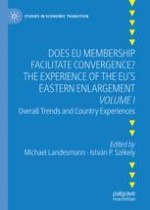2021 | OriginalPaper | Buchkapitel
3. Towards a New Growth Model in CESEE: Three Challenges Ahead
verfasst von : Luca Gattini, Áron Gereben, Miroslav Kollár, Debora Revoltella, Patricia Wruuck
Erschienen in: Does EU Membership Facilitate Convergence? The Experience of the EU's Eastern Enlargement - Volume I
Aktivieren Sie unsere intelligente Suche, um passende Fachinhalte oder Patente zu finden.
Wählen Sie Textabschnitte aus um mit Künstlicher Intelligenz passenden Patente zu finden. powered by
Markieren Sie Textabschnitte, um KI-gestützt weitere passende Inhalte zu finden. powered by
